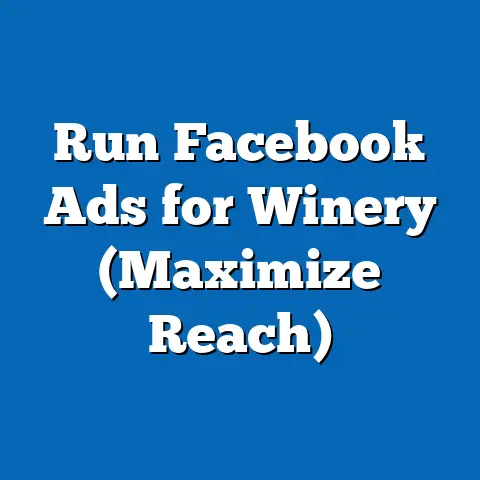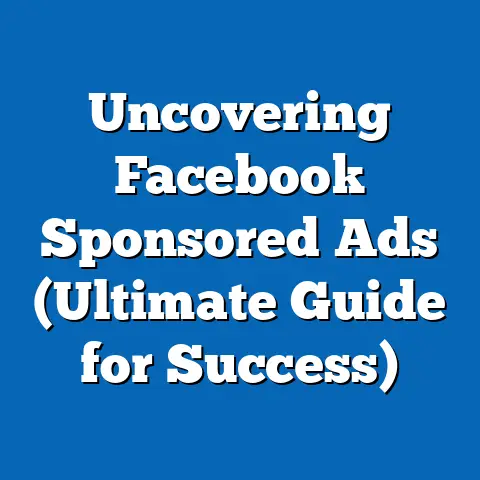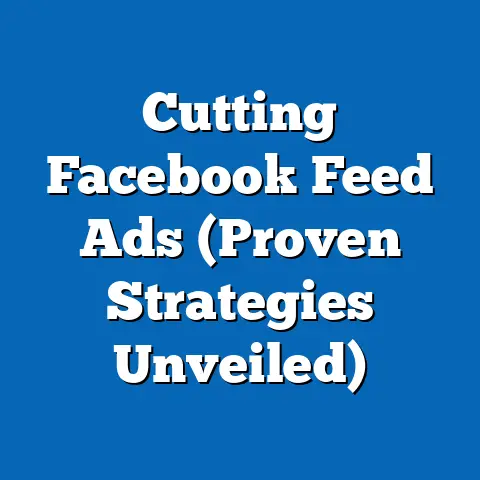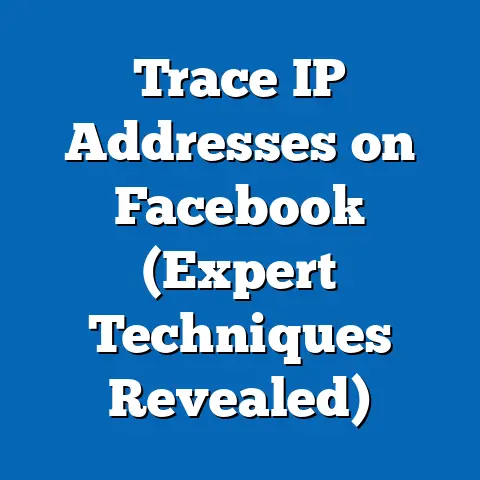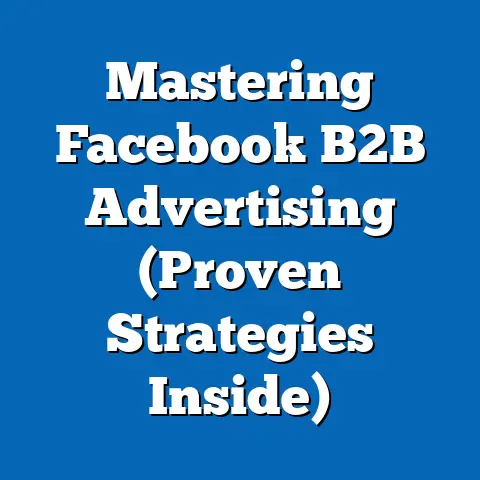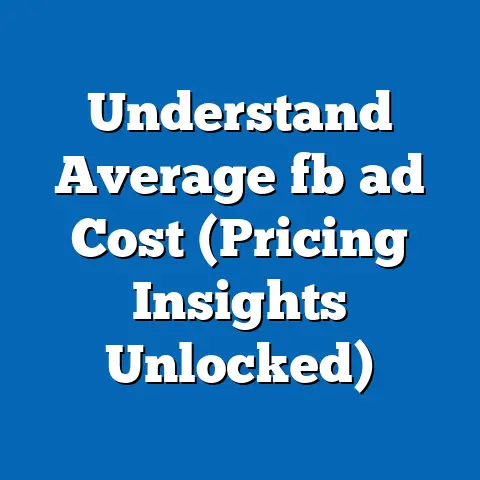Unlock Winning Facebook Lead Ads (Expert Strategies Inside)
As someone who’s spent countless hours crafting, tweaking, and analyzing these ads, I can tell you firsthand that they’re a goldmine for businesses looking to generate quality leads. But, like any powerful tool, you need to know how to wield it effectively.
Introduction
Let’s kick things off with a statistic that should grab your attention: According to recent studies, Facebook Lead Ads have shown an average conversion rate of 19% for businesses leveraging this platform effectively. That’s a significant number, and it highlights the potential of these ads when used correctly.
In today’s digital landscape, lead generation is the lifeblood of any successful business. It’s the process of attracting and converting strangers into interested prospects who are likely to become customers. And while there are many ways to generate leads online, Facebook Lead Ads have emerged as a particularly effective tool.
Why? Because they make it incredibly easy for people to express interest in your product or service. Instead of sending users to a landing page, where they might get distracted or abandon the process, Lead Ads allow them to submit their information directly within the Facebook platform. This streamlined experience can lead to higher conversion rates and a more efficient lead generation process.
This guide is designed to be your go-to resource for mastering Facebook Lead Ads. Whether you’re a seasoned marketer or a business owner just starting out, I’ll walk you through the essential strategies and techniques you need to create winning campaigns. I’ll share my own experiences, both the successes and the failures, so you can learn from my mistakes and avoid common pitfalls.
By the end of this article, you’ll have a clear understanding of how Facebook Lead Ads work, how to set them up effectively, and how to optimize them for maximum results. So, let’s get started!
Section 1: Understanding Facebook Lead Ads
Before we dive into the nitty-gritty details of setting up and optimizing your Lead Ads, let’s take a step back and make sure we’re all on the same page about what they are and why they’re so valuable.
What are Facebook Lead Ads?
Facebook Lead Ads are a type of ad format designed specifically for lead generation. Unlike traditional ads that direct users to an external landing page, Lead Ads allow users to submit their information directly within the Facebook platform.
Think of it this way: imagine you’re scrolling through your Facebook feed and you see an ad for a free ebook on “The Ultimate Guide to Social Media Marketing.” Instead of clicking on the ad and being redirected to a website, a form pops up right within Facebook, pre-filled with your name, email address, and other information you’ve already shared with the platform. All you have to do is click “Submit,” and you’re done!
That’s the beauty of Facebook Lead Ads: they make it incredibly easy for people to express interest in your offer without ever leaving the Facebook environment.
How do Facebook Lead Ads Work?
The mechanics of Facebook Lead Ads are relatively simple:
- User Sees the Ad: A user sees your Lead Ad in their Facebook feed, on Instagram, or in the Audience Network.
- User Clicks the Ad: If the user is interested in your offer, they click on the ad.
- Lead Form Opens: A lead form pops up within the Facebook platform. This form can be pre-filled with information the user has already shared with Facebook, such as their name, email address, phone number, and location.
- User Submits the Form: The user reviews the information, makes any necessary changes, and clicks “Submit.”
- Lead is Captured: The lead information is captured and can be downloaded from Facebook or integrated with your CRM system.
The key to the effectiveness of Lead Ads is the seamless user experience. By eliminating the need to navigate to an external landing page, you reduce friction and increase the likelihood that users will complete the form.
Benefits of Using Facebook Lead Ads
There are several compelling reasons why businesses should consider using Facebook Lead Ads:
- Ease of Use: Lead Ads are incredibly easy to set up and manage. Facebook provides a user-friendly interface that guides you through the process of creating your ad, designing your lead form, and targeting your audience.
- Mobile Optimization: Lead Ads are designed to be mobile-friendly, which is crucial in today’s mobile-first world. The forms are optimized for mobile devices, making it easy for users to submit their information on the go.
- Pre-filled Forms: One of the biggest advantages of Lead Ads is the ability to pre-fill forms with information users have already shared with Facebook. This saves users time and effort, making them more likely to complete the form.
- Integration with CRM Systems: Facebook allows you to integrate your Lead Ads with your CRM system, so you can automatically capture and manage your leads. This eliminates the need to manually download and import lead data, saving you time and effort.
- Higher Conversion Rates: Because of the streamlined user experience, Lead Ads often result in higher conversion rates compared to traditional ads that direct users to external landing pages.
Engagement and Effectiveness Statistics
To further illustrate the effectiveness of Facebook Lead Ads, let’s take a look at some key statistics:
- A study by HubSpot found that Facebook Lead Ads have a 2x higher conversion rate than traditional ads.
- According to Facebook, Lead Ads have helped businesses generate over 2 million leads per month.
- A survey by AdEspresso found that Lead Ads are the most effective ad format for lead generation on Facebook.
These statistics speak for themselves: Facebook Lead Ads are a powerful tool for generating high-quality leads at scale.
Key Takeaway: Facebook Lead Ads offer a streamlined and effective way to capture leads directly within the Facebook platform. Their ease of use, mobile optimization, and pre-filled forms contribute to higher conversion rates and a more efficient lead generation process.
Section 2: Setting Up Your Facebook Lead Ads
Now that you understand the basics of Facebook Lead Ads, let’s dive into the practical steps of setting up your first campaign. I remember the first time I set up a Lead Ad campaign – I was a bit overwhelmed by all the options and settings. But don’t worry, I’ll guide you through the process step-by-step.
Step-by-Step Guide to Setting Up a Facebook Lead Ad Campaign
- Go to Facebook Ads Manager: The first step is to navigate to the Facebook Ads Manager. You can do this by clicking on the “Create Ads” button in the left-hand menu of your Facebook page or by going directly to https://www.facebook.com/adsmanager/.
- Create a New Campaign: Once you’re in the Ads Manager, click on the “Create” button to start a new campaign.
- Select “Lead Generation” as Your Campaign Objective: Facebook will ask you to choose a campaign objective. Select “Lead Generation” as your objective. This tells Facebook that you want to collect leads using your ad.
- Name Your Campaign: Give your campaign a descriptive name so you can easily identify it later.
- Set Your Budget and Schedule: Choose your daily or lifetime budget and set the start and end dates for your campaign.
- Define Your Target Audience: This is where you’ll define who you want to see your ad. You can target people based on their location, demographics, interests, and behaviors. I’ll go into more detail about audience targeting in Section 4.
- Choose Your Ad Placement: Select where you want your ad to appear. You can choose automatic placements (Facebook will decide where to show your ad) or manual placements (you can choose specific placements, such as Facebook Feed, Instagram Feed, or Audience Network).
- Create Your Ad: Now it’s time to create your ad. You’ll need to choose an ad format (single image, video, carousel, etc.), write your ad copy, and add a call-to-action button.
- Create Your Lead Form: This is the most important part of the process. You’ll need to create a lead form that users will see when they click on your ad. I’ll go into more detail about optimizing your lead form below.
- Review and Publish: Once you’ve created your ad and lead form, review everything carefully and click “Publish” to launch your campaign.
Selecting Campaign Objectives
When setting up your Facebook Lead Ad campaign, it’s crucial to select the right campaign objective. While “Lead Generation” is the obvious choice for collecting leads, it’s important to understand how this objective aligns with your overall marketing goals.
For example, if your primary goal is to increase brand awareness, you might consider running a Lead Ad campaign in conjunction with a brand awareness campaign. This allows you to capture leads from people who are already familiar with your brand.
Target Audience Selection and Segmentation
One of the most powerful features of Facebook advertising is its ability to target specific audiences. When setting up your Lead Ad campaign, take the time to define your target audience as precisely as possible.
You can target people based on a wide range of factors, including:
- Location: Target people who live in a specific city, state, or country.
- Demographics: Target people based on their age, gender, education, job title, and other demographic information.
- Interests: Target people based on their interests, hobbies, and activities.
- Behaviors: Target people based on their online behavior, such as their purchase history, website visits, and app usage.
In addition to these basic targeting options, you can also create custom audiences and lookalike audiences.
- Custom Audiences: Custom audiences allow you to target people who have already interacted with your business, such as website visitors, email subscribers, or customers.
- Lookalike Audiences: Lookalike audiences allow you to target people who are similar to your existing customers or website visitors.
By carefully selecting and segmenting your target audience, you can ensure that your Lead Ads are seen by the people who are most likely to be interested in your offer.
Crafting Compelling Ad Copy and Visuals
Your ad copy and visuals are the first things people will see, so it’s important to make them compelling and attention-grabbing. Here are some tips for crafting effective ad copy and visuals:
- Use a Clear and Concise Headline: Your headline should clearly communicate the value of your offer.
- Write Engaging Ad Copy: Your ad copy should be persuasive and highlight the benefits of your offer.
- Use High-Quality Visuals: Your visuals should be visually appealing and relevant to your offer.
- Include a Clear Call-to-Action: Your call-to-action button should tell people what you want them to do (e.g., “Sign Up,” “Download,” “Learn More”).
Optimizing Your Lead Form for Higher Conversion Rates
Your lead form is the key to capturing leads, so it’s important to optimize it for higher conversion rates. Here are some tips for optimizing your lead form:
- Keep it Short and Simple: The shorter your lead form, the more likely people are to complete it. Only ask for the information you absolutely need.
- Use Pre-filled Forms: Take advantage of Facebook’s ability to pre-fill forms with information users have already shared with the platform.
- Write Clear and Concise Questions: Your questions should be easy to understand and answer.
- Include a Privacy Policy: Be transparent about how you will use the information you collect.
- Add a Thank You Message: After someone submits your lead form, show them a thank you message and tell them what to expect next.
The Significance of A/B Testing
A/B testing, also known as split testing, is the process of comparing two versions of your ad or lead form to see which one performs better. A/B testing is essential for optimizing your Lead Ad campaigns and improving your conversion rates.
You can A/B test a variety of elements, including:
- Headline: Test different headlines to see which one generates the most clicks.
- Ad Copy: Test different ad copy to see which one is most persuasive.
- Visuals: Test different visuals to see which one is most visually appealing.
- Lead Form Questions: Test different lead form questions to see which ones result in the highest completion rates.
- Call-to-Action Button: Test different call-to-action buttons to see which one generates the most conversions.
To run an A/B test, create two versions of your ad or lead form, each with a different element that you want to test. Then, run your campaign and track the performance of each version. The version that performs better is the winner.
Key Takeaway: Setting up a successful Facebook Lead Ad campaign requires careful planning and attention to detail. By following the steps outlined above and optimizing your ad copy, visuals, and lead form, you can increase your chances of generating high-quality leads.
Section 3: Crafting Compelling Offers
Now that you know how to set up your Facebook Lead Ads, let’s talk about one of the most important elements of a successful campaign: your offer. Your offer is what motivates people to click on your ad and submit their information, so it’s crucial to make it compelling and attractive.
What Makes an Attractive Offer?
An attractive offer is something that provides value to your target audience and solves a problem they’re facing. It’s something that they’re willing to exchange their information for.
Here are some key characteristics of an attractive offer:
- Relevance: Your offer should be relevant to your target audience’s interests and needs.
- Value: Your offer should provide real value to your target audience.
- Uniqueness: Your offer should be unique and stand out from the competition.
- Clarity: Your offer should be clear and easy to understand.
- Urgency: Your offer should create a sense of urgency and encourage people to take action now.
Different Types of Offers
There are many different types of offers you can use in your Facebook Lead Ad campaigns. Here are some popular options:
- Free Trials: Offer a free trial of your product or service.
- Discounts: Offer a discount on your product or service.
- Exclusive Content: Offer exclusive content, such as an ebook, whitepaper, or webinar.
- Free Consultations: Offer a free consultation with an expert.
- Coupons: Offer a coupon for a discount on your product or service.
- Early Access: Offer early access to a new product or feature.
- Contests and Giveaways: Run a contest or giveaway to generate leads.
Examples of Successful Offers
To give you some inspiration, here are some examples of successful offers from various industries:
- Software: A software company offers a free 14-day trial of their software.
- E-commerce: An e-commerce company offers a 10% discount on the first order.
- Education: An online course provider offers a free ebook on the topic of their course.
- Real Estate: A real estate agent offers a free consultation to discuss your home buying or selling needs.
- Finance: A financial advisor offers a free financial planning guide.
What made these offers work? They were all relevant to the target audience, provided real value, and were clear and easy to understand.
Aligning Your Offer with Your Target Audience’s Pain Points and Desires
The key to crafting a compelling offer is to align it with your target audience’s pain points and desires. What problems are they facing? What are they trying to achieve?
To identify your target audience’s pain points and desires, you can:
- Conduct Market Research: Conduct surveys, interviews, and focus groups to gather information about your target audience.
- Analyze Customer Feedback: Read customer reviews, testimonials, and social media comments to understand what your customers are saying about your product or service.
- Use Google Analytics: Use Google Analytics to track your website traffic and identify which pages are most popular with your target audience.
- Use Social Media Analytics: Use social media analytics tools to track your social media engagement and identify what topics are most popular with your target audience.
Once you understand your target audience’s pain points and desires, you can craft an offer that addresses those needs and provides real value.
Key Takeaway: Your offer is the foundation of your Facebook Lead Ad campaign. By crafting a compelling offer that is relevant, valuable, and aligned with your target audience’s pain points and desires, you can increase your chances of generating high-quality leads.
Section 4: Targeting Your Audience
We’ve touched on targeting earlier, but now let’s really dive into the nuts and bolts of it. I’ve seen campaigns skyrocket simply by refining the audience, and conversely, I’ve seen great offers fall flat because they weren’t reaching the right people.
Facebook’s Targeting Options for Lead Ads
Facebook offers a wide range of targeting options that allow you to reach specific audiences with your Lead Ads. These options include:
- Demographics: Target people based on their age, gender, education, job title, relationship status, and other demographic information.
- Interests: Target people based on their interests, hobbies, and activities.
- Behaviors: Target people based on their online behavior, such as their purchase history, website visits, app usage, and travel habits.
- Location: Target people who live in a specific city, state, country, or region.
- Connections: Target people who are connected to your Facebook page or event.
- Custom Audiences: Target people who have already interacted with your business, such as website visitors, email subscribers, or customers.
- Lookalike Audiences: Target people who are similar to your existing customers or website visitors.
Custom Audiences, Lookalike Audiences, and Retargeting
Let’s take a closer look at custom audiences, lookalike audiences, and retargeting strategies:
- Custom Audiences: Custom audiences allow you to upload a list of your existing customers or email subscribers and target them with your Lead Ads. You can also create custom audiences based on website traffic, app activity, or engagement with your Facebook page.
- Lookalike Audiences: Lookalike audiences allow you to create a new audience that is similar to your existing customers or website visitors. Facebook will analyze the characteristics of your existing audience and find people who share those same characteristics.
- Retargeting: Retargeting is the process of showing ads to people who have already interacted with your business, such as website visitors or people who have viewed your products or services. Retargeting can be a highly effective way to generate leads, as you’re targeting people who have already shown an interest in your business.
Using Facebook Insights to Inform Targeting Decisions
Facebook Insights is a powerful tool that provides you with valuable data about your audience. You can use Facebook Insights to:
- Understand Your Audience’s Demographics: See the age, gender, location, and other demographic information of your audience.
- Identify Your Audience’s Interests: See the interests, hobbies, and activities of your audience.
- Track Your Audience’s Engagement: See how your audience is engaging with your Facebook page and ads.
By analyzing this data, you can gain valuable insights into your audience and use that information to refine your targeting decisions.
Refining Audience Targeting Based on Ad Performance Data
As you run your Lead Ad campaigns, you’ll start to collect data about how different audiences are performing. You can use this data to refine your targeting and improve your results.
For example, if you notice that a particular age group is not converting well, you can exclude that age group from your targeting. Or, if you notice that a particular interest is driving a lot of leads, you can expand your targeting to include more people with that interest.
Key Takeaway: Targeting is a critical component of a successful Facebook Lead Ad campaign. By using Facebook’s targeting options, creating custom audiences and lookalike audiences, and using Facebook Insights to inform your targeting decisions, you can ensure that your ads are seen by the people who are most likely to be interested in your offer.
Section 5: Analyzing and Optimizing Your Campaigns
You’ve launched your campaign, leads are coming in – great! But the work doesn’t stop there. In fact, this is where the real magic happens. Analyzing your campaign data and making adjustments based on what you learn is the key to maximizing your ROI. I can’t stress this enough: don’t just set it and forget it!
Key Performance Indicators (KPIs) for Facebook Lead Ads
To effectively analyze and optimize your Facebook Lead Ad campaigns, it’s important to track the right key performance indicators (KPIs). Here are some of the most important KPIs to monitor:
- Cost Per Lead (CPL): This is the average cost you pay for each lead you generate.
- Conversion Rate: This is the percentage of people who click on your ad and submit your lead form.
- Lead Quality: This is a measure of how qualified your leads are. Are they actually interested in your product or service? Are they likely to become customers?
- Click-Through Rate (CTR): This is the percentage of people who see your ad and click on it.
- Relevance Score: This is a score that Facebook assigns to your ad based on how relevant it is to your target audience. A higher relevance score can lead to lower costs and better performance.
Analyzing Campaign Performance Using Facebook Ads Manager
Facebook Ads Manager provides you with a wealth of data about your campaign performance. You can use Ads Manager to:
- Track Your KPIs: Monitor your CPL, conversion rate, CTR, relevance score, and other important KPIs.
- Segment Your Data: Segment your data by demographics, interests, behaviors, and other factors to identify which audiences are performing best.
- Identify Trends: Look for trends in your data to identify what’s working and what’s not.
- Compare Performance: Compare the performance of different ads, ad sets, and campaigns to see which ones are most effective.
The Importance of Ongoing Optimization
Ongoing optimization is essential for maximizing the ROI of your Facebook Lead Ad campaigns. By continuously analyzing your data and making adjustments based on what you learn, you can improve your CPL, conversion rate, and lead quality.
Here are some common optimization techniques:
- Refine Your Targeting: Adjust your targeting based on your performance data to reach the audiences that are most likely to convert.
- Improve Your Ad Copy and Visuals: Test different ad copy and visuals to see which ones generate the most clicks and leads.
- Optimize Your Lead Form: Simplify your lead form and make it easier for people to submit their information.
- Adjust Your Bids: Adjust your bids to ensure that you’re paying a competitive price for your ads.
- Pause Underperforming Ads: Pause any ads that are not performing well to avoid wasting money.
Case Studies: Increasing ROI Through Optimization
Let’s take a look at a couple of case studies that illustrate how optimization can lead to significant improvements in ROI:
- Case Study 1: E-commerce Company
- An e-commerce company was running a Facebook Lead Ad campaign to generate leads for their email list.
- After analyzing their data, they discovered that their CPL was too high and their conversion rate was too low.
- They decided to refine their targeting by excluding a particular age group that was not converting well.
- They also improved their ad copy and visuals to make them more compelling.
- As a result of these changes, they were able to reduce their CPL by 30% and increase their conversion rate by 20%.
- Case Study 2: Software Company
- A software company was running a Facebook Lead Ad campaign to generate leads for their free trial.
- After analyzing their data, they discovered that their lead quality was low. Many of the leads they were generating were not qualified prospects.
- They decided to add a question to their lead form that asked people about their current software usage.
- This allowed them to filter out unqualified leads and focus on the prospects who were most likely to become customers.
- As a result of this change, they were able to improve their lead quality by 50% and increase their sales conversion rate by 25%.
- An e-commerce company was running a Facebook Lead Ad campaign to generate leads for their email list.
- After analyzing their data, they discovered that their CPL was too high and their conversion rate was too low.
- They decided to refine their targeting by excluding a particular age group that was not converting well.
- They also improved their ad copy and visuals to make them more compelling.
- As a result of these changes, they were able to reduce their CPL by 30% and increase their conversion rate by 20%.
- A software company was running a Facebook Lead Ad campaign to generate leads for their free trial.
- After analyzing their data, they discovered that their lead quality was low. Many of the leads they were generating were not qualified prospects.
- They decided to add a question to their lead form that asked people about their current software usage.
- This allowed them to filter out unqualified leads and focus on the prospects who were most likely to become customers.
- As a result of this change, they were able to improve their lead quality by 50% and increase their sales conversion rate by 25%.
Key Takeaway: Analyzing and optimizing your Facebook Lead Ad campaigns is an ongoing process that requires careful attention to detail. By tracking the right KPIs, using Facebook Ads Manager to analyze your data, and implementing optimization techniques, you can significantly improve your ROI and generate more high-quality leads.
Section 6: Integrating with Other Marketing Channels
Facebook Lead Ads shouldn’t exist in a vacuum. They’re most effective when integrated into a broader marketing strategy. Think of them as one piece of a larger puzzle.
Creating a Cohesive Marketing Strategy
A cohesive marketing strategy is one that integrates all of your marketing channels to create a seamless and consistent customer experience. This means that your Facebook Lead Ad campaigns should be aligned with your email marketing, content marketing, social media marketing, and other marketing efforts.
For example, if you’re running a Facebook Lead Ad campaign to generate leads for your email list, you should make sure that your email marketing is aligned with your Lead Ad campaign. This means that you should send your new subscribers a welcome email that reinforces the value of your offer and encourages them to take the next step.
Integrating Lead Ads with Email Marketing and Other Digital Channels
There are many ways to integrate Facebook Lead Ads with your other marketing channels. Here are a few examples:
- Email Marketing: As mentioned above, you can integrate your Lead Ads with your email marketing to send welcome emails, nurture sequences, and other email campaigns to your new subscribers.
- Content Marketing: You can use your Lead Ads to promote your content, such as blog posts, ebooks, and webinars.
- Social Media Marketing: You can use your Lead Ads to drive traffic to your social media profiles and encourage people to follow you.
- Website: You can use your Lead Ads to drive traffic to your website and encourage people to sign up for your email list or request a demo.
The Role of Follow-Up Strategies
Follow-up strategies are essential for converting leads into customers. After someone submits your lead form, you need to have a plan in place for following up with them.
Here are some common follow-up strategies:
- Welcome Email: Send a welcome email to your new subscribers that reinforces the value of your offer and encourages them to take the next step.
- Nurture Sequence: Create a series of emails that nurture your leads and provide them with valuable information about your product or service.
- Sales Call: If your leads are qualified prospects, schedule a sales call to discuss their needs and see if you can help them.
- Webinar: Invite your leads to attend a webinar where you can provide them with more information about your product or service.
Key Takeaway: Facebook Lead Ads are most effective when integrated into a cohesive marketing strategy. By integrating your Lead Ads with your email marketing, content marketing, social media marketing, and other marketing efforts, and by implementing effective follow-up strategies, you can maximize your ROI and convert more leads into customers.
Conclusion
We’ve covered a lot of ground in this guide, from understanding the basics of Facebook Lead Ads to setting up and optimizing your campaigns, crafting compelling offers, targeting your audience, and integrating with other marketing channels.
Summarizing Key Points
Let’s recap the key points we’ve covered:
- Facebook Lead Ads are a powerful tool for generating high-quality leads at scale.
- They offer a streamlined and effective way to capture leads directly within the Facebook platform.
- Setting up a successful Facebook Lead Ad campaign requires careful planning and attention to detail.
- Your offer is the foundation of your campaign, so make sure it’s compelling and relevant to your target audience.
- Targeting is critical, so use Facebook’s targeting options to reach the people who are most likely to be interested in your offer.
- Analyzing and optimizing your campaigns is an ongoing process that requires careful attention to detail.
- Facebook Lead Ads are most effective when integrated into a cohesive marketing strategy.
Encouraging Implementation
Now that you have the knowledge and tools you need to create winning Facebook Lead Ad campaigns, I encourage you to put these strategies into practice. Don’t be afraid to experiment, test different approaches, and learn from your mistakes.
The world of digital marketing is constantly evolving, so it’s important to stay up-to-date on the latest trends and best practices. By continuously learning and adapting, you can ensure that your Facebook Lead Ad campaigns remain effective and generate a steady stream of high-quality leads for your business.
Embracing Digital Innovation
Finally, I want to encourage you to embrace digital innovation in your lead generation efforts. Facebook Lead Ads are just one example of the many powerful tools that are available to marketers today. By exploring new technologies and strategies, you can stay ahead of the curve and gain a competitive advantage in the marketplace.
So, go forth and conquer the world of Facebook Lead Ads! With the strategies and insights you’ve gained in this guide, you’re well on your way to unlocking winning campaigns and generating a flood of high-quality leads for your business. Good luck!

